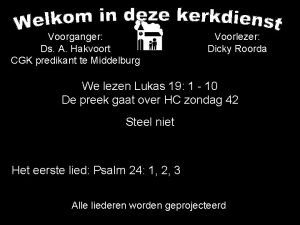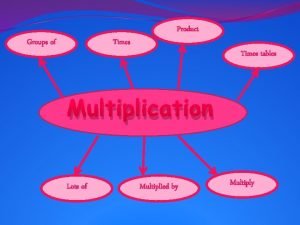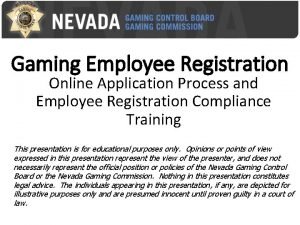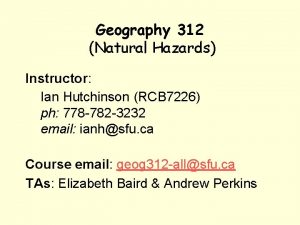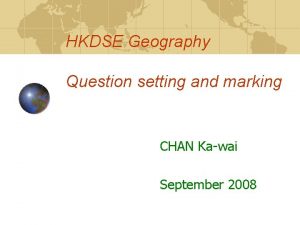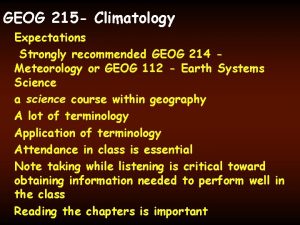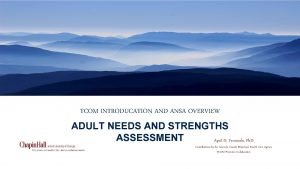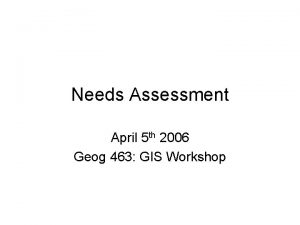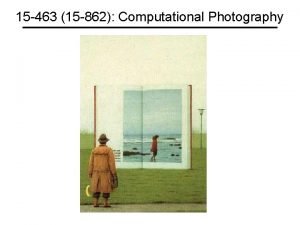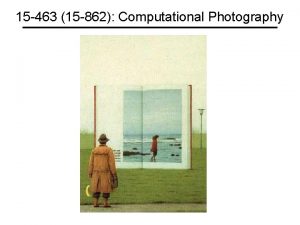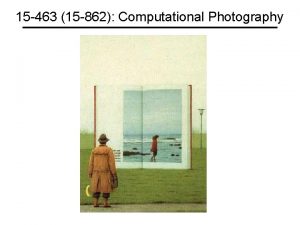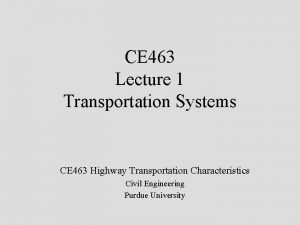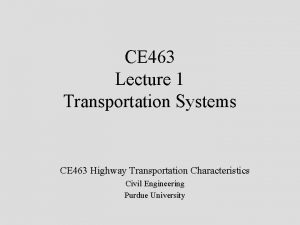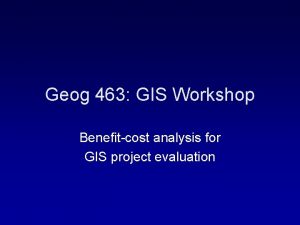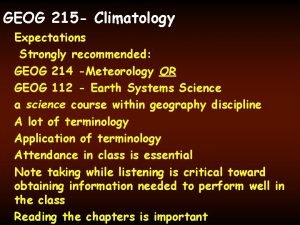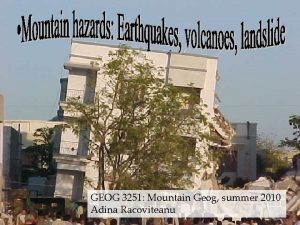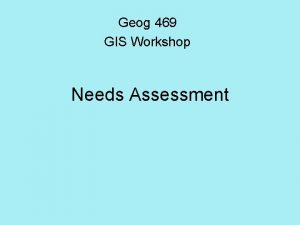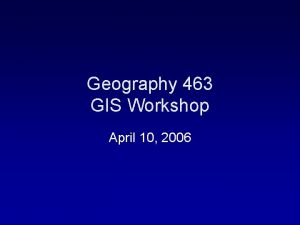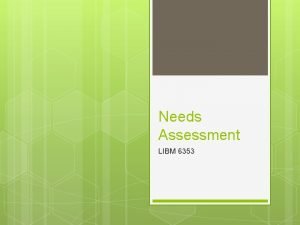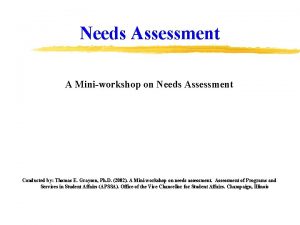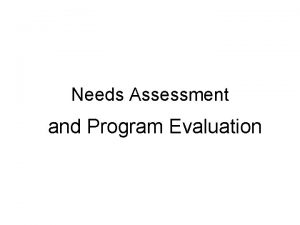Needs Assessment April 5 th 2006 Geog 463


















- Slides: 18

Needs Assessment April 5 th 2006 Geog 463: GIS Workshop

Outlines • • Rational behinds needs assessment Benefits of GIS projects Hierarchical view on needs assessment Information product description

Rationales behind needs assessment • What is needs assessment? – Process of identifying what is expected from the project – Can be thought of as a blueprint (i. e. planning) • Why needs assessment? – Cost of not planning? – Expectation management – Helps you identify potential problems • Why do we have to know about organization? – Is need-to-know question in alignment with goals of organization?

Why expectation management is critical… picture of the reality… This image is retrieved from Tom Nolan’s lecture note Importance of communication!

What are benefits of GIS projects? • • • Save money/cost avoidance Save time Increase efficiency Increase accuracy Increase productivity Increase communication and collaboration Generate revenue Support decision making Automate work flow Build an information base Manage resources Improve access to government… Which of the following categories does your project fit into? From “measuring up the business case for GIS”

The scope of GIS projects • Will determine – The level of benefits • Large-scope GIS projects is more likely to reduce cost since it will make the use of shared database (e. g. centralized database) and benefit from automation – The roles of GIS in an organization • Large-scope GIS is more likely to change the way the organization does business – Strategies for needs assessment • The larger the scope of GIS projects, the more it is necessary to find out the organization and business work flow Given the scope of your project, how would you assess these three items?

Application, Information product, data, business work flow, and GIS To find out business workflow, ask “what do you do? ” To find out information product, ask “what do you need to do that function? ” Image source: Tomlinson (2005)

What is business work flow? – Models of complex business processes – Can be thought of the way the organization does the business • E. g. land-use development approvals, building loan approvals, permitting, conservation land planning, service delivery, and distributed facilities management – Information products comes out of that work flow – GIS functionalities can be utilized within the context of business work flow, and also have a potential to change/redesign business work flow How does need-to-know question of your project fit into the larger business work flow?

Hierarchical view on needs assessment Goal Function Facility Entity Attribute Adapted from Huxhold 1991, Introduction to Urban GIS

Hierarchical view on needs assessment • Goal: one of the major strategic directions for the organization – E. g. Maintain the urban infrastructure – E. g. Reduce crime – E. g. Create jobs for the citizens • Function: a major activity within the organization which supports a goal of the organization – E. g. Repair city streets – E. g. Enforce the building codes – E. g. Assess the value of property For geog 463 candidate projects, think of “need-to-know” question as function

Hierarchical view on needs assessment • Facility: the physical, legal, or other object upon which a function of the organization is performed (i. e. database: a collection of related entities) – E. g. Street, Building, Parcel • Entity: Components of the facilities that are managed by the various responsibilities of the organization (i. e. spatial object) – E. g. pavement, curbs, cutters • Attributes: descriptive data that define the characteristics of the entity – E. g. location, condition, size, date, type

Information products description • What is information products? – What comes out of the GIS – Output that answers need-to-know questions – Such deliverables would include • List of potential sites for skate park or bridge construction & associated rankings (tabular requirements) • Narratives of ranking methodology (text requirements) • Map of socioeconomic variables in China • Map showing changes in income gap in Seattle • Diagram that shows the potential database design (schematic requirements)

Steps for information products description • What would be the title that best describes information product? • What’s the name of the department and person who needs information product? • Write the synopsis of the information product needed • Sketch requirements of information structure which can be any combination of the following: – Map, tabular, text, image, 3 D, schematic requirements – Work on details of each requirement (e. g. which feature should be included in the map? ) – What would the requirement look like? Draw possible outcomes – Similar to Map Inventory from MPLIS chapter 16

For each information product Input data Processing needs Information product Step 1: __________ Step 2: __________ Step 3: __________ Step 4: __________ Step 5: __________ Which GIS functionalities are needed for each step?

Steps for information products description • Which data set is needed for meeting requirements of information structure? – If you can, come up with standard name for each data set – Is the data set available? – If data is not readily available, where is data? how can we obtain the data? • Which GIS functionalities are invoked at each step to make the product? – Attribute query, data input, spatial query, display, edit, label, symbolize, create list

Frequency of use • Identify the most frequently used GIS functionalities – If IPD leads you to the conclusion that satellite image processing is the most frequently used functionality and the organization does not have image processing (e. g. ERDAS IMAGINE) software, you should consider purchasing the software. • Number of times a product is created in one year * number of times a functionality is used = number of times a functionality is used to create the product in one year • Create top-ten functionalities list required from the GIS overall; the list will be useful in scoping your system requirements particularly s/w and h/w requirement

Logical linkages • Determine the relationships required between the data elements (does an information product require the linkage between data elements? ) • Three types of logical linkages – Relationships between lists and graphic entities (e. g. land parcel and its value) for attribute/spatial query – Relationships between maps (e. g. hazard zone and population) for spatial overlay where coordinate systems of two maps should be considered – Relationships between attributes (e. g. house and sewer); referential keys should be established • Helpful in scoping the system requirement particularly data requirements

Error tolerance • How much error would clients tolerate? • No error is good, but costly – The second best is sometimes optimal as suggested by economists • Data quality vs. fitness-for-use – Meeting the expectation given by a particular application, not necessarily meeting the generic use • Helpful in seeking the balance between benefit and cost; you should find “bargaining position” • Consider possible occurrence, results of error, impact on benefits, and concerns for error tolerance (see p. 60 -61 in Tomlinson for examples)
 Paula hurlock birthday
Paula hurlock birthday Deped school calendar 2005-2006
Deped school calendar 2005-2006 Liedboek 463
Liedboek 463 Lied 463
Lied 463 46 times tables
46 times tables Math 463
Math 463 Gaming employee registration login
Gaming employee registration login Unit 1 geog. of ga/ga’s beginnings
Unit 1 geog. of ga/ga’s beginnings Free floating subdivisions
Free floating subdivisions Geog 312 sfu
Geog 312 sfu Geography dse
Geography dse Geog 214
Geog 214 Geog
Geog Primary needs and secondary needs
Primary needs and secondary needs Primary needs and secondary needs
Primary needs and secondary needs Simple claustral complex
Simple claustral complex Strategic gender needs and practical gender needs
Strategic gender needs and practical gender needs Graves 2000
Graves 2000 Adult needs and strengths assessment
Adult needs and strengths assessment


